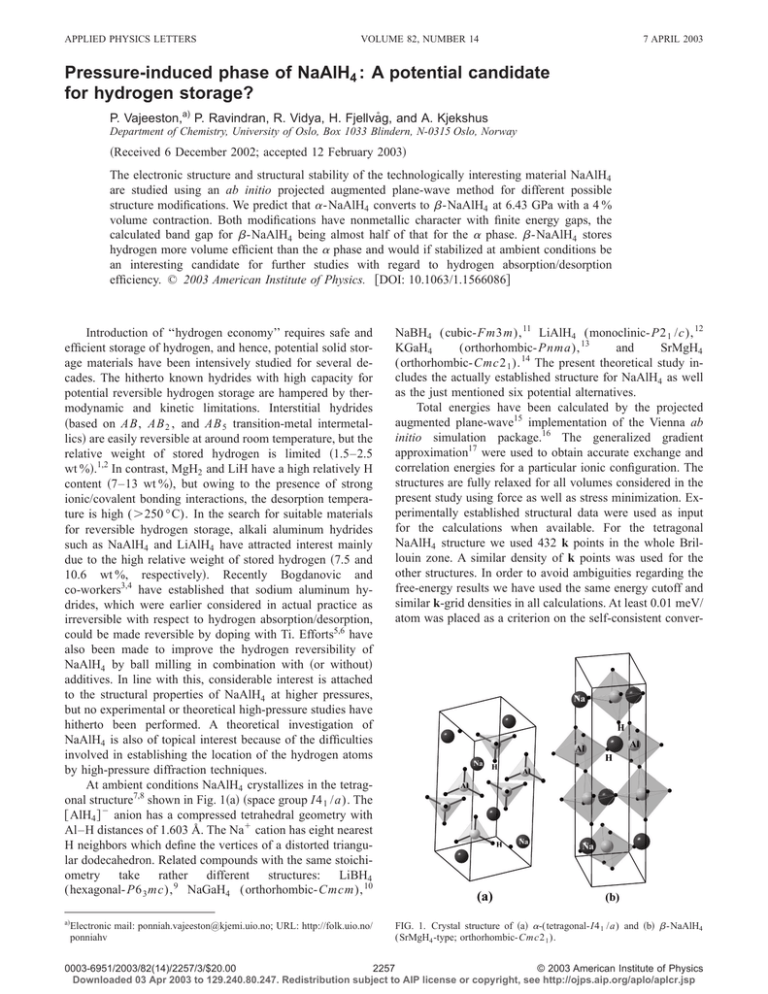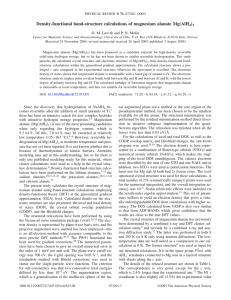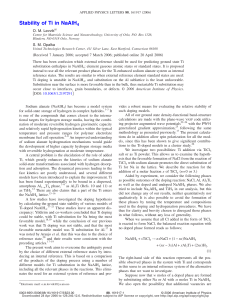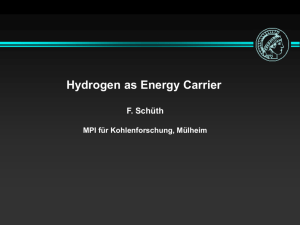Pressure-induced phase of NaAlH : A potential candidate for hydrogen storage?
advertisement

APPLIED PHYSICS LETTERS VOLUME 82, NUMBER 14 7 APRIL 2003 Pressure-induced phase of NaAlH4 : A potential candidate for hydrogen storage? P. Vajeeston,a) P. Ravindran, R. Vidya, H. Fjellvåg, and A. Kjekshus Department of Chemistry, University of Oslo, Box 1033 Blindern, N-0315 Oslo, Norway 共Received 6 December 2002; accepted 12 February 2003兲 The electronic structure and structural stability of the technologically interesting material NaAlH4 are studied using an ab initio projected augmented plane-wave method for different possible structure modifications. We predict that ␣ -NaAlH4 converts to  -NaAlH4 at 6.43 GPa with a 4 % volume contraction. Both modifications have nonmetallic character with finite energy gaps, the calculated band gap for  -NaAlH4 being almost half of that for the ␣ phase.  -NaAlH4 stores hydrogen more volume efficient than the ␣ phase and would if stabilized at ambient conditions be an interesting candidate for further studies with regard to hydrogen absorption/desorption efficiency. © 2003 American Institute of Physics. 关DOI: 10.1063/1.1566086兴 Introduction of ‘‘hydrogen economy’’ requires safe and efficient storage of hydrogen, and hence, potential solid storage materials have been intensively studied for several decades. The hitherto known hydrides with high capacity for potential reversible hydrogen storage are hampered by thermodynamic and kinetic limitations. Interstitial hydrides 共based on AB, AB 2 , and AB 5 transition-metal intermetallics兲 are easily reversible at around room temperature, but the relative weight of stored hydrogen is limited 共1.5–2.5 wt %兲.1,2 In contrast, MgH2 and LiH have a high relatively H content 共7–13 wt %兲, but owing to the presence of strong ionic/covalent bonding interactions, the desorption temperature is high (⬎250 °C). In the search for suitable materials for reversible hydrogen storage, alkali aluminum hydrides such as NaAlH4 and LiAlH4 have attracted interest mainly due to the high relative weight of stored hydrogen 共7.5 and 10.6 wt %, respectively兲. Recently Bogdanovic and co-workers3,4 have established that sodium aluminum hydrides, which were earlier considered in actual practice as irreversible with respect to hydrogen absorption/desorption, could be made reversible by doping with Ti. Efforts5,6 have also been made to improve the hydrogen reversibility of NaAlH4 by ball milling in combination with 共or without兲 additives. In line with this, considerable interest is attached to the structural properties of NaAlH4 at higher pressures, but no experimental or theoretical high-pressure studies have hitherto been performed. A theoretical investigation of NaAlH4 is also of topical interest because of the difficulties involved in establishing the location of the hydrogen atoms by high-pressure diffraction techniques. At ambient conditions NaAlH4 crystallizes in the tetragonal structure7,8 shown in Fig. 1共a兲 共space group I4 1 /a). The 关 AlH4 兴 ⫺ anion has a compressed tetrahedral geometry with Al–H distances of 1.603 Å. The Na⫹ cation has eight nearest H neighbors which define the vertices of a distorted triangular dodecahedron. Related compounds with the same stoichiometry take rather different structures: LiBH4 (hexagonal- P6 3 mc), 9 NaGaH4 (orthorhombic-Cmcm), 10 NaBH4 (cubic-Fm3m), 11 LiAlH4 (monoclinic- P2 1 /c), 12 KGaH4 (orthorhombic- Pnma), 13 and SrMgH4 (orthorhombic-Cmc2 1 ). 14 The present theoretical study includes the actually established structure for NaAlH4 as well as the just mentioned six potential alternatives. Total energies have been calculated by the projected augmented plane-wave15 implementation of the Vienna ab initio simulation package.16 The generalized gradient approximation17 were used to obtain accurate exchange and correlation energies for a particular ionic configuration. The structures are fully relaxed for all volumes considered in the present study using force as well as stress minimization. Experimentally established structural data were used as input for the calculations when available. For the tetragonal NaAlH4 structure we used 432 k points in the whole Brillouin zone. A similar density of k points was used for the other structures. In order to avoid ambiguities regarding the free-energy results we have used the same energy cutoff and similar k-grid densities in all calculations. At least 0.01 meV/ atom was placed as a criterion on the self-consistent conver- a兲 FIG. 1. Crystal structure of 共a兲 ␣-(tetragonal-I4 1 /a) and 共b兲  -NaAlH4 (SrMgH4 -type; orthorhombic-Cmc2 1 ). Electronic mail: ponniah.vajeeston@kjemi.uio.no; URL: http://folk.uio.no/ ponniahv 0003-6951/2003/82(14)/2257/3/$20.00 2257 © 2003 American Institute of Physics Downloaded 03 Apr 2003 to 129.240.80.247. Redistribution subject to AIP license or copyright, see http://ojps.aip.org/aplo/aplcr.jsp 2258 Vajeeston et al. Appl. Phys. Lett., Vol. 82, No. 14, 7 April 2003 TABLE I. Optimized structural parameters for ␣-共tetragonal I4 1 /a) and  -NaAlH4 (SrMgH4 -type; orthorhombic Cmc2 1 ). Phase ␣  a Unit cell 共Å兲 a⫽4.9965 ⫽4.9801a c⫽11.0828 ⫽11.1483a a⫽3.5493 b⫽13.8304 c⫽5.1133 Atomic coordinates Na: 0, 1/4, 1/8; Al: 0, 1/4, 5/8; H: 0.2199, 0.3710, 0.5639 0.2372,a 0.3869,a 0.5456a Na: 0, 0.1708, 0.2373 共0, 0.1695, 0.2409兲;b Al: 0, 0.4147, 0.2056 共0, 0.4139, 0.2047兲;b H共1兲: 0, 0.3485, 0.4807 共0, 0.3476, 0.4877兲;b H共2兲: 0, 0.3147, 0.0117 共0, 0.3105, 0.0116兲;b H共3兲: 0, 0.0763, 0.6842 共0, 0.0751, 0.6811兲;b H共4兲: 0, 0.5232, 0.3816 共0, 0.5269, 0.3739兲b Experimentally observed values from Ref. 8. Atomic coordinates at transition point 共in parentheses兲. b FIG. 2. Calculated unit-cell volume vs free energy for NaAlH4 in different structural arrangements. Arrow marks the ␣ →  transition. gence of the total energy, and the calculations reported here used a plane wave cutoff of 600 eV. The zero-point entropy contribution to the free energy has not been included in the calculations, but its contribution should in any case be very small and should not affect transition pressures significantly.18 A similar approach was successfully applied in the case of MgH2 , where the three experimentally observed high-pressure phases where reproduced rather well.19 In agreement with the experimental findings,7,8 the actual tetragonal structure takes the lowest energy 共Fig. 2兲 among the seven considered phases. Hence, at ambient conditions NaAlH4 crystallizes in the tetragonal structure 共hereafter named as the ␣ phase兲 with lattice constants a ⫽4.9965 and c⫽11.0828 Å, 关close 共within 1 %兲 to the lowtemperature 共8 K兲 experimental values8 of a⫽4.9801 and c ⫽11.1483 Å]. Similarly the calculated atomic coordinates for ␣ -NaAlH4 are in good agreement with experimental findings 共Table I兲. At higher pressures, ␣ -NaAlH4 transforms to an orthorhombic SrMgH4 -type structure 兵space group Cmc2 1 关Figs. 1共b兲 and 2兴; hereafter  -NaAlH4 其. The coordination number 共CN兲 of Al changes from 4 in ␣ -NaAlH4 to 6 in the  phase, viz. consistent with the expected general trend of increasing CN with weakening of the covalent/ionic bonding with increasing pressure. We have calculated the total energy as a function of unit-cell volume for 12 different volumes and fitted the results to the so-called universal equation state20 and thus obtained bulk moduli (B 0 ) and pressure derivatives (B 0⬘ ) for ␣- and  -NaAlH4 . Both phases have low bulk moduli (B 0 ⫽19.3 and 36.5 GPa; B 0⬘ ⫽4.77 and 3.78, respectively兲 implying that NaAlH4 is a very soft and easily compressible material. B 0 for  -NaAlH4 is almost twice that of the ␣ phase, largely due to the increased CN and the lower equilibrium volume of  -NaAlH4 . The theoretically generated pressure-volume curve 共Fig. 3兲 shows that ␣ -NaAlH4 is converted into the  phase at 6.43 GPa with a volume reduction of ⬃4 %. In order to obtain a clearer picture of the conditions at the transition point and the possibility for formation of the  phase, we show the pressure dependence of the Gibbs free energy difference (⌬G) between the ␣- and  -NaAlH4 in the inset to Fig. 3. The calculated total-energy difference 共Fig. 2兲 between the two structures at their equilibrium volumes is only 126 meV/f.u. 共12.2 kJ/mol兲. The equilibrium volume of  -NaAlH4 at 1 bar is 9% smaller than that of the ␣ phase 共see Fig. 2兲, indicating that hydrogen can be stored more efficiently in the  phase. At higher pressures the involved energy difference between ␣- and  -NaAlH4 is small. In line with the findings for TiO2 21 one should search for possibilities to stabilize the high-pressure phase  -NaAlH4 at ambient pressure by appropriate treatment 共perhaps by chemical means, that moreover may open up for improved reversible hydrogen absorption/desorption kinetics兲. The calculated density of states 共DOS兲 for ␣ -NaAlH4 共at equilibrium兲 and  -NaAlH4 共at transition pressure兲 are shown in Fig. 4. Both phases have nonmetallic character with finite band gaps (⌬E g ⬇5.04 and 2.35 eV for ␣- and  -NaAlH4 , respectively兲. The energetic degeneration of the FIG. 3. Pressure-volume relationship for NaAlH4 . Inset: Stability of ␣ -NaAlH4 relative to  -NaAlH4 in terms of pressure. Arrows mark the transition pressure. Downloaded 03 Apr 2003 to 129.240.80.247. Redistribution subject to AIP license or copyright, see http://ojps.aip.org/aplo/aplcr.jsp Vajeeston et al. Appl. Phys. Lett., Vol. 82, No. 14, 7 April 2003 2259 ␣ -NaAlH4 are in good agreement with the experimental values. Both ␣- and  -NaAlH4 have nonmetallic character with finite band gaps. The coordination number of Al in  -NaAlH4 is six as compared with four for ␣ -NaAlH4 . At the high pressures where  -NaAlH4 rules, the Al-p states are more delocalized and the large DOSs at the top of the VB are moved to lower energies compared with the ␣ phase. This leads to a gain in the band-energy contribution to the total energy with pressure, and this may be the reason for the ␣-to- phase transition. The authors greatfully acknowledge the Research Council of Norway for financial support and for computer time at the Norwegian supercomputer facilities. G. Sabdrock, J. Alloys Compd. 293–295, 877 共1999兲. G. Sabdrock and G. Thomas, IEA/DOE/SNL Hydride Databases, http:// hydpaek.ca.sandia.gov. 3 B. Bogdanovic and M. Schwickardi, J. Alloys Compd. 253–254, 1 共1997兲. 4 B. Bogdanovic, R. A. Brand, A. Marjanovic, M. Schwikardi, and J. Tölle, J. Alloys Compd. 302, 36 共2000兲. 5 A. Zaluska, L. Zaluski, and J. O. Ström-Olsen, J. Alloys Compd. 298, 125 共2000兲. 6 C. M. Jensen and K. J. Gross, Appl. Phys. A: Mater. Sci. Process. 72, 213 共2001兲. 7 V. K. Belskii, B. M. Bulychev, and A. V. Golubeva, Acta Crystallogr., Sect. B: Struct. Crystallogr. Cryst. Chem. 38, 1254 共1982兲. 8 B. C. Hauback, H. W. Brinks, C. M. Jensen, and A. J. Maeland 共unpublished兲. 9 J. P. Soulié, G. Renaudin, R. Éerný, and K. Yvon, J. Alloys Compd. 346, 200 共2002兲. 10 A. V. Irodova, V. A. Somenkov, I. V. Kurchatovy, S. I. Bakum, S. F. Kuznetsova, and N. S. Kurnakov, Z. Phys. Chem. 共Frankfurt/Main兲 163, 239 共1989兲. 11 R. L. Davis and C. H. L. Kennardy, J. Solid State Chem. 59, 393 共1985兲. 12 B. C. Hauback, H. W. Brinks, and H. Fjellvåg, J. Alloys Compd. 346, 184 共2002兲. 13 S. I. Backum, A. V. Irodova, S. F. Kuznetsova, O. I. Lyakhovitskaya, Y. Z. Nozik, and V. A. Somenkov, Koord. Khim. 16, 1210 共1990兲. 14 F. Gingl, K. Yvon, and P. Fischer, J. Alloys Compd. 187, 105 共1992兲. 15 P. E. Blöchl, Phys. Rev. B 50, 17953 共1994兲; G. Kresse and J. Joubert, ibid. 59, 1758 共1999兲. 16 G. Kresse and J. Hafner, Phys. Rev. B 47, R6726 共1993兲; G. Kresse and J. Furthmuller, Comput. Mater. Sci. 6, 15 共1996兲. 17 J. P. Perdew, in Electronic Structure of Solids, edited by P. Ziesche and H. Eschrig 共Akademie, Berlin, 1991兲, p. 11; J. P. Perdew, K. Burke, and Y. Wang, Phys. Rev. B 54, 16533 共1996兲, J. P. Perdew, S. Burke, and M. Ernzerhof, Phys. Rev. Lett. 77, 3865 共1996兲. 18 G. Grimvall, Thermophysical Properties of Materials 共Elsevier, Amsterdam, 1999兲. 19 P. Vajeeston, P. Ravindran, A. Kjekshus, and H. Fjellvåg, Phys. Rev. Lett. 89, 175506 共2002兲. 20 P. Vinet, J. H. Rose, J. Ferrante, and J. R. Smith, J. Phys.: Condens. Matter 1, 1941 共1989兲. 21 L. S. Dubrovinsky, N. A. Dubrovinskaia, V. Swamy, J. Muscat, N. M. Harrison, R. Ahuja, B. Holm, and B. Johansson, Nature 共London兲 410, 653 共2001兲. 1 2 FIG. 4. Calculated DOS for 共a兲 ␣- and 共b兲  -NaAlH4 . The Fermi level is set at zero energy and marked by the vertical lines, s electron contributions are marked with dotted regions. Al-p and H-s states together with a spatially favorable constellation of Al and H facilitate covalent bonding between Al and H. ⌬E g for  -NaAlH4 is only about half of that for ␣ -NaAlH4 and there are significant differences between the DOS for the two phases, especially the broadening and shifting of the bands. The partial DOS of Na shows that the s and p states are energetically degenerate in the whole energy range, while Al-s and -p states are well separated in both phases. On going from ␣- to  -NaAlH4 the width of the valence band is increased from 6 to 8 eV, which is partially due to the decrease in the interatomic Al–H, Al–Na, and Na–H distances. Moreover, owing to the increase in the hybridization of Al-p with H-s at elevated pressures, the center of the Al-p band is shifted from ⬃⫺1.5 eV in ␣ -NaAlH4 to ⬃⫺3.5 eV in the  phase. The reduction in the band gap and the increase in the CN of the  phase indicate that the tendency toward metallic nature increases with pressure. Hence, one could expect appreciable differences in the kinetics of the hydrogen-storage properties of the ␣ and  phases. In conclusion, on application of pressure ␣ -NaAlH4 is predicted to transform into a  phase at 6.43 GPa with a 4% volume reduction. The calculated structural parameters for Downloaded 03 Apr 2003 to 129.240.80.247. Redistribution subject to AIP license or copyright, see http://ojps.aip.org/aplo/aplcr.jsp






